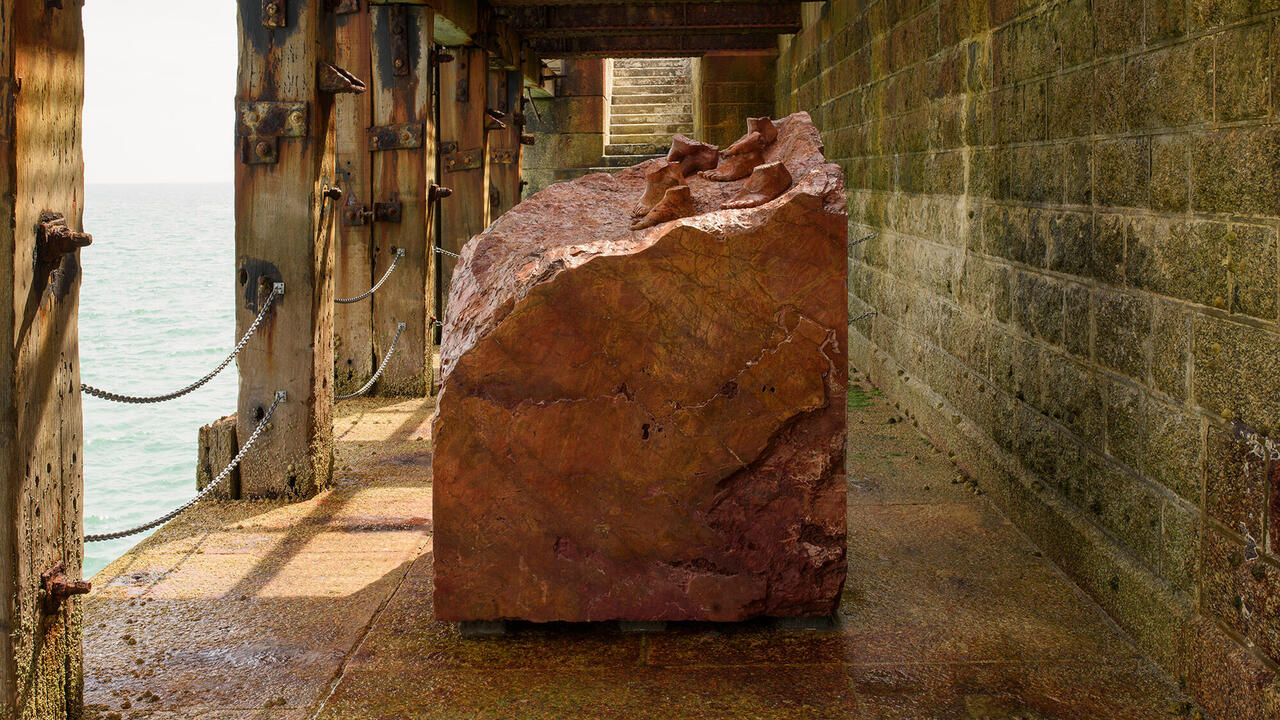Sitings: Installation Art 1969-2002

The scene is a boiler room in the basement of P.S.1, a converted schoolhouse in Long Island City, New York. The room is at the bottom of a stairway; a shallow pit separates the entryway from the boiler on the far side. Black wooden planks are laid over the length of the cavity, with six wooden stools below, creating a bleak classroom, an ugly, refracted version of the former school upstairs. Two bare light bulbs dangle from electrical cables on the ceiling to hang below the planks, giving a murky, obstructed light.
A voice, that of Vito Acconci, speaks from beneath the makeshift desks. He is a schoolmaster announcing the day's lessons. 'Lesson Number One: Let's be suckers.' From the opposite corner, his voice repeats, 'Ready? Let's be suckers.' A chorus of overdubbed Acconcis, acting out the voices of multiple students, repeats the lesson by rote: 'We-Are-Suck-ers! Repeat: We-are Suck-ers!' The lesson ventriloquizes and deforms the lessons of the educational institution that gives it place, and makes visible the contempt writhing in the foundations of the American educational system. The piece also critiques the didactic moralism of architecture itself: it's not a coincidence that 'edifice' and 'edification' share the same Latin root. Architecture is historically conflated with spiritual enlightenment, with intellectual improvement; that is, with education. Acconci's work, titled Under-history Lessons (1976-87), was meant to undermine the former status of the school and to make visible a sickness at the heart of the architecture's moralistic stance.
The inclusion of Under-history Lessons in the MoCA's Geffen's retrospective 'Sitings: Installation Art 1969-2002' highlights serious problems in the basic premise of the show. What does it mean to shift the place of this work? It is to the gallery's credit that we can even ask this question: the institution has been exceptionally brave in its acquisitions over the last 15 years, though its bravery has forced it to face head-on the wholesale collapse of the modern museum's traditional goals. MoCA is in a bind, caught between specificity and historicization. How does a museum deal with artists' changing ideas about how, or whether, their work ought to be preserved? What does conservation mean in regard to art intended to age, to have a lifespan? What does it mean to move art whose structure of meaning is built around a particular site? Under-history Lessons, for example, seemed somewhat nonsensical in the Geffen's immense hangar, robbed of the nasty criticality it must have had in 1976. Here, Acconci sounded merely ghoulish, a low-rent Vincent Price.
In 'Sitings' the questions that MoCA is so good at asking have answers that are not thought through or botched at every turn. The basic premise of the show - to exhibit a retrospective of installation art - posed problems, not least because the museum had an inchoate definition of the term to work with in the first place. Installation art is primarily a catch-all; its constituents, from Cady Noland to Olafur Eliasson to Diana Thater, have little in common and little to say to one another. The genre seems to gesture towards works that are 'immersive', though one might ask then whether a Diego Rivera mural, the Merzbau or a Gothic cathedral could not also be so described. What the term meant here was a sequence of cinematically darkened rooms in which to be immersed. The exhibition resembled nothing so much as a makeshift Cineplex or a series of tableaux vivants. If MoCA took particular pains to reinstall the works accurately, it was in the service of creating full-scale replicas of the original works: naturalistic dioramas of stuffed avant-gardist wildlife.
If installation art has any character at all, it resides in its demand for isolation: each work must take up an entire room, and no less. Imagine the transgressive charge of installing Sarah Sze's tricksy, intricately balanced Many a Slip (1999) inside the newly portable corridor of Mike Kelley's once meaningful Pay for Your Pleasure (1988), or people wolfing down Rirkrit Tiravanija's mussels in the theatre of Allan Sekula's dull Untitled Slide Sequence (1972). It's self-defeating to narrate connections between the supposed hits of installation art, to present connections and conflicts between works, for each artwork is defined by its intention to stand haughtily alone. Perhaps installation artists are unified only in their mutual disdain for the wicked machinations of curators and by the disgust they feel at the sight of other artists' work. In that sense Acconci's lessons were a bitter parody of the hapless tone of the entire exhibition, the only installation pointing towards the fakeness of the history that 'Sitings' was meant to compile: 'Lesson Three: Let's believe we're in this togetherrrr.'
















